Are certain lead segments more important than others? While the process of managing an engagement strategy can be multi-faceted and time-consuming, developing the core understanding and putting a plan in place is actually a lot simpler than you think. We’ll cover how to: Develop an optimized newsletter strategy Build a welcome series Personalize and segment your lists Offer subscription preferences Re-engage dormant leads Develop the fundamentals of good database management Let’s begin. In a recent post, we detailed five important ways to take your newsletter strategy to the next level. The last key area of developing a newsletter plan is create a testing strategy and calendar. Subscribers and members receive different welcome series. The reason for this is to not only determine who our new subscribers are, but how they opted-in. This is where operational emails that offer this option or subscription preference centers can majorly increase the level of lead engagement. In order to offer a highly customized experience while reducing your opportunity for unsubscribes, you need to create a subscription preferences center to allow subscribers and leads to choose the types of emails they receive. While it’s focused more on Marketo, the same can be put together across other marketing automation platforms.
For enterprise marketers, there are key factors that contribute
to the overall success of your email marketing strategy.
Technology is becoming more sophisticated, and so should your
success metrics.
As
Marketo states, “A riveting subject line or persuasive email
copy is only as good as the revenue it generates: You don’t just
want opens; you want actual sales.”
That’s where email engagement and ROI attribution come into
play.
So, how do you define email engagement, you may ask?
It’s a question that has plagued marketers for some time, and
marketing automation programs have different ways to measure
it.
For example, Marketo uses a proprietary algorithm that
quantifies those core metrics, plus a statistical algorithm, to
create a single numeric value. They use 50/100 as a threshold for
an “average” email send performance, benchmarked against nurturing
emails:

On the other hand, Pardot
creates a data report for how your recipients engage with your
email over time. They use activity as a means of engagement:
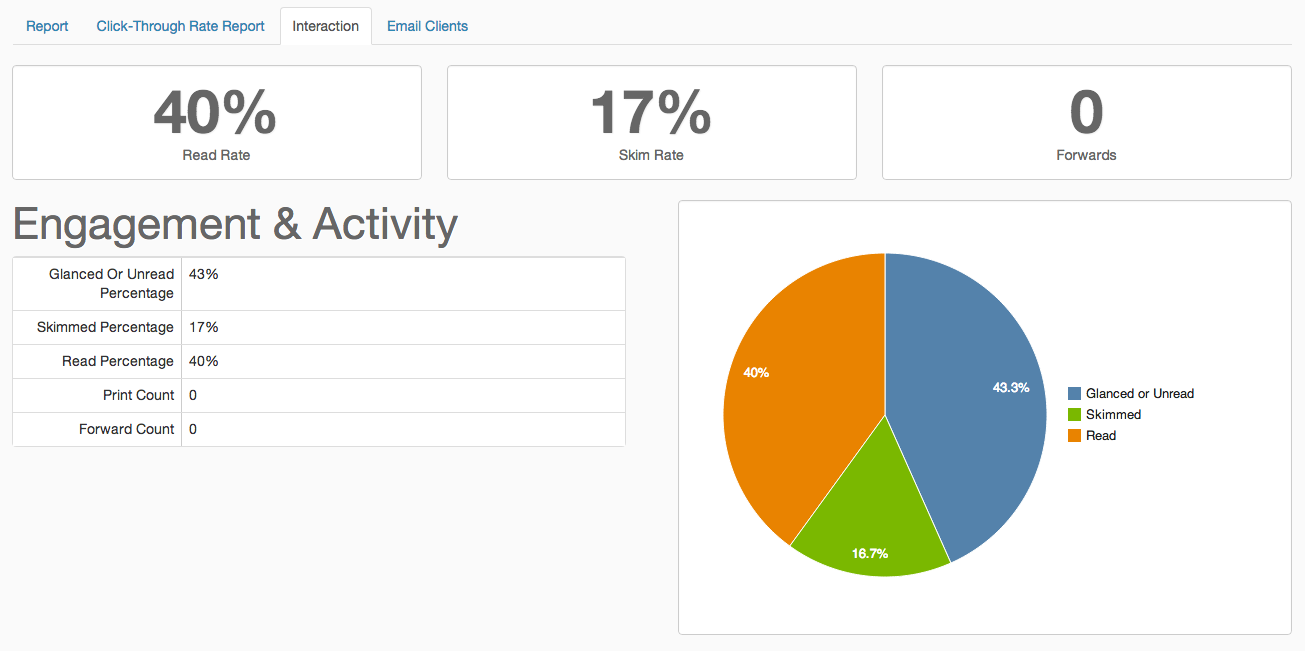
Whatever platform you’re using, the important thing to consider
is what success looks like for your company and your subscribers.
You can begin by asking questions such as:
- What is the long-term engagement of your subscribers?
- How are you measuring lifecycle engagement at each stage of the
funnel? - Are certain behaviors or categories more important than
others? - Are certain lead segments more important than others?
Once you’ve defined success, you can put a plan in place to get
there.
When you’re looking to attribute email engagement to your
overall marketing KPI performance like increasing brand equity or
driving marketing-influenced revenue, you must first determine the
basics: Your purpose, goals, and plan for optimization.
From there, you can then dive into nurturing, lifecycle
marketing, and database management for a 360-degree view of
marketing engagement across your brand.
While the process of managing an engagement strategy can be
multi-faceted and time-consuming, developing the core understanding
and putting a plan in place is actually a lot simpler than you
think.
In this post, we’ll look at what this strategic process looks
like. We’ll cover how to:
- Develop an optimized newsletter strategy
- Build a welcome series
- Personalize and segment your lists
- Offer subscription preferences
- Re-engage dormant leads
- Develop the fundamentals of good database management
Let’s begin.
1) Develop an Optimized Newsletter Strategy
At the core of your email strategy (and to an extent, your
marketing strategy) is a well-thought out newsletter program. In
its simplest form, the newsletter is your opportunity to showcase
your thought leadership, industry or company news, and
calls-to-action for premium content, events, webinars, and other
brand-specific marketing programs tied to your lead nurturing
strategy.
In a recent post, we detailed five important ways to take your
newsletter strategy to the next level. As you consider each
step, be sure to consider your newsletter’s purpose and goals, and
make sure that every decision will work towards them.
Step 1: Create a Documented Strategy
When setting up your newsletter strategy, you should look at the
following aspects to determine your overall approach:
- Email cadence
- Number of articles per newsletter
- Target open rate
- Target clicks/traffic
This will allow you to create a framework from which you can
benchmark and improve.
Step 2: Determine Layout and Formatting
Next, you’ll want to consider the look and feel of your
newsletter. This involves determining the amount of information
you’ll provide, your branding, and how the design can impact your
goal performance numbers.
There are generally three options when it comes to your
newsletter layout:
- The Simple Newsletter Format: A minimalist
layout that you can customize to your needs and use for
testing. - The Complex Newsletter Format: A more detailed
layout with many different pieces of content to draw readers’
attention. You’re going to want to focus on click-throughs, when
choosing this option. - The Choose-Your-Own-Adventure Format: If you
have the time and resources, you can allow your subscribers the
option to pick the format they want. This feature is better
supported through the use of a marketing automation platform like
Marketo or Pardot.
Consider using Litmus’
free selection of newsletter templates that have been
pre-tested to be responsive and email client-friendly. You simply
opt-in to download their entire template database and cherry-pick
what you want.
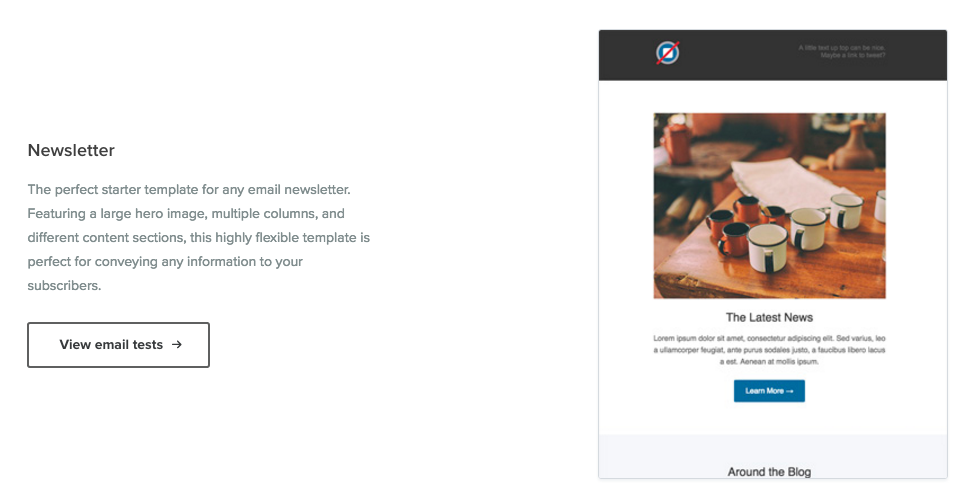
Another option is to check out ReallyGoodEmails.com. It’s a
personal favorite of mine because they provide inspiring examples
of newsletters used by famous brands around the world.
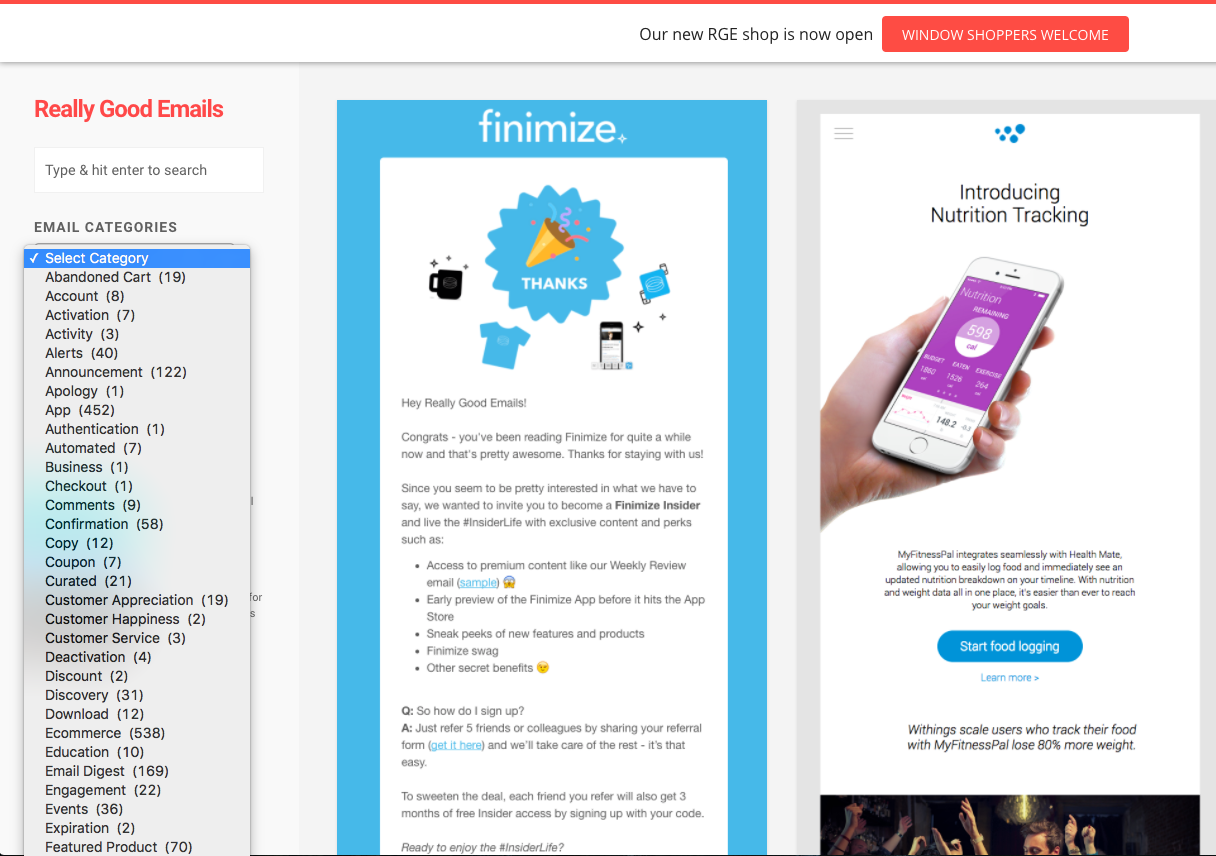
They are also broken up into categories and most offer the
actual code of the email so you can extract and re-purpose the
layout to suit your own brand.
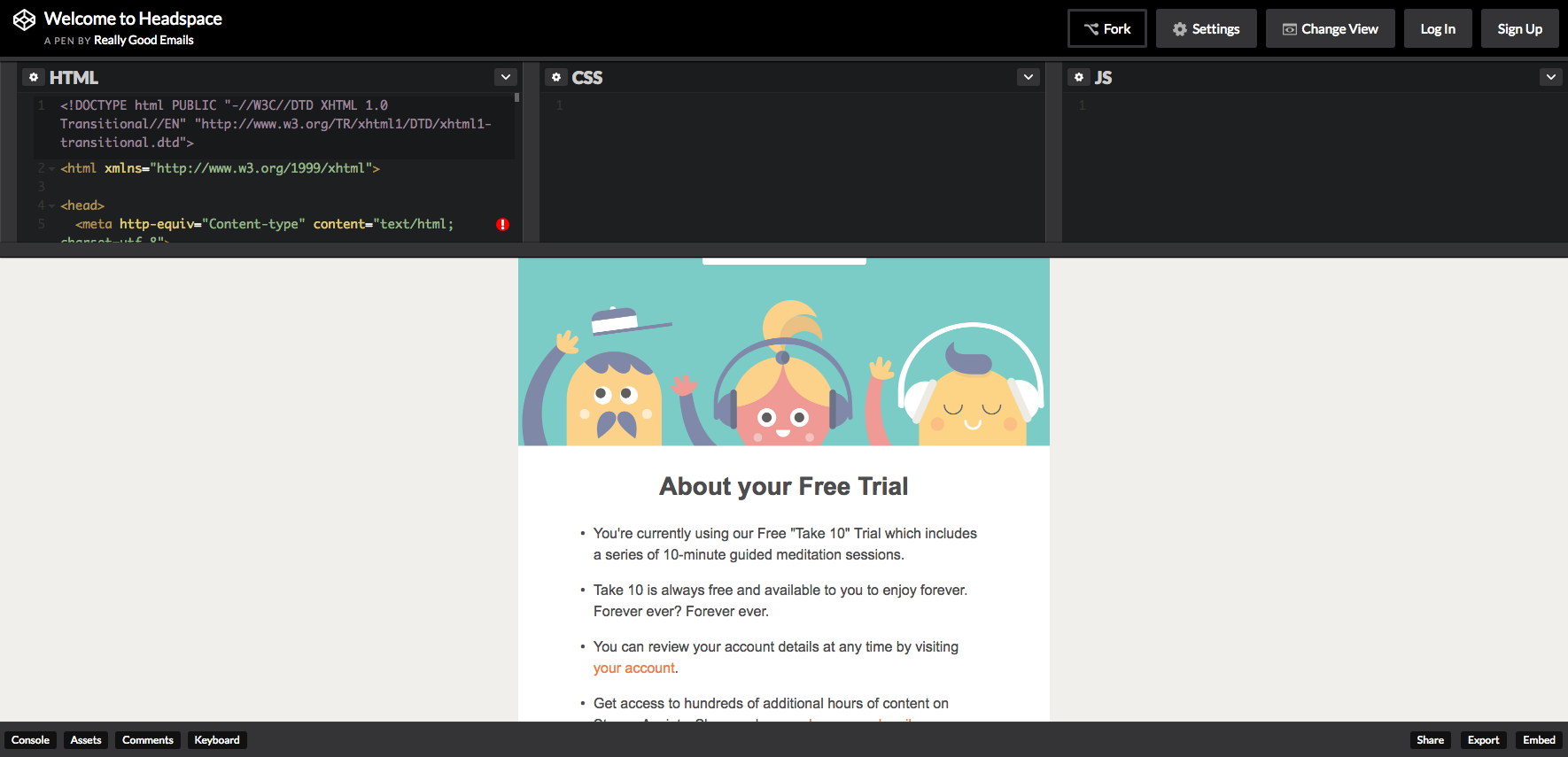
Step 3: Set up Newsletter KPIs
This step is key: Developing a KPI plan will allow you to
effectively measure the success of your newsletter program. You can
do this a number of ways including, but not limited to:
- Developing a scorecard
- Creating an analytics framework
- Using channel traffic information
- Setting UTM parameters
- Understanding behavioral goals
Read more about each of those KPIs here.
By developing the foundation for measuring success, you can then
build out the plan to optimize your newsletter program and ensure
it’s meeting your engagement goals.
Step 4: Optimize Newsletter Performance
With a foundational strategy, smart layout decision, and core
metrics to benchmark against, you can work to increase the overall
performance of your newsletters through the following steps:
- Create a newsletter name. Think of catchy
names that will make your newsletter memorable. Check out HubSpot’s
post on
some of the best newsletter examples around to help get your
creative juices flowing. - Be mobile friendly. According to Litmus’ Email
Analytics Report, as of September, 2016,
56% of email open rates occurred on a mobile device. - Be inbox friendly. Consider the subject line,
avoid spam triggers, and consider preheader text and any sort
of personalization to attract your audience into opening the email.
The more engaged they are with your newsletter, the more likely it
will continue to show up in their inbox.
Step 5: Always Test!
The last key area of developing a newsletter plan is create a
testing strategy and calendar. Determine what you plan on testing,
for how long, and what you plan to do with this data.
Ask yourself questions, such as:
- What am I focusing on improving? Open rates?
Click-throughs? - How long do I need to test this to have enough data to support
my hypothesis? - What kinds of tests can I run based on what I’m focusing?
By focusing on benchmarks with your tests, you will always find
room to improve and keep your newsletter as fresh and engaging as
possible.
2) Build a Welcome Series
The great thing about new subscribers is that they’re a more
highly engaged bunch! However, unlike longer term subscribers who
understand your story, new subscribers are, well, new.
As
email service provider MyEmma puts it: “Think of it this way.
When someone walks into your store, do you immediately ask for
their credit card number? Nope. First, you craft an experience that
creates connection and warmth – a helpful associate, a gorgeous
product display, a cool video tutorial. The email equivalent? A
welcome series.”
The welcome series is statistically the best email (or series of
emails) you will ever send.
The reason?
You can predict the level of engagement and improve list quality
at the same time.
As MarketingLand stated in their post on
predicting subscriber engagement and value, 64% of overall
engagement levels were attributed to the welcome series (see image
below). They also determined that a welcome series resulted in 42%
greater read rate based on tests from Google, Yahoo, and AOL.
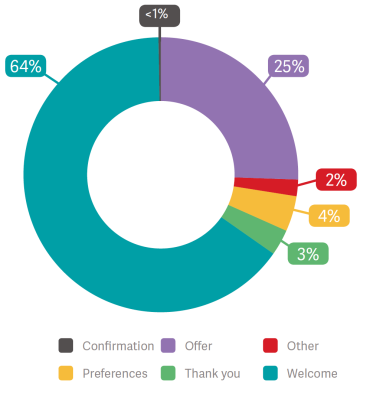
MarketingLand also saw that the success of a welcome series
directly correlated to the engagement of a list overtime. In the
same analysis, “it was found that subscribers that read the initial
welcome message were far more likely to read subsequent messages
from a brand. While messages being read by subscribers dropped
dramatically after the first welcome email was read, future
messages were read at about a 50% rate for 180 days after.”
Look at the welcome series as an opportunity to increase overall
conversion rates, upsell readers to higher value content, and move
quality leads further down the funnel.
For example, HubSpot does a fantastic job laying the foundation
of what to expect from their welcome series, while also providing
opportunities to download more high value content. I guarantee that
if HubSpot still does any sort of manual lead scoring, I was scored
according to what I clicked.
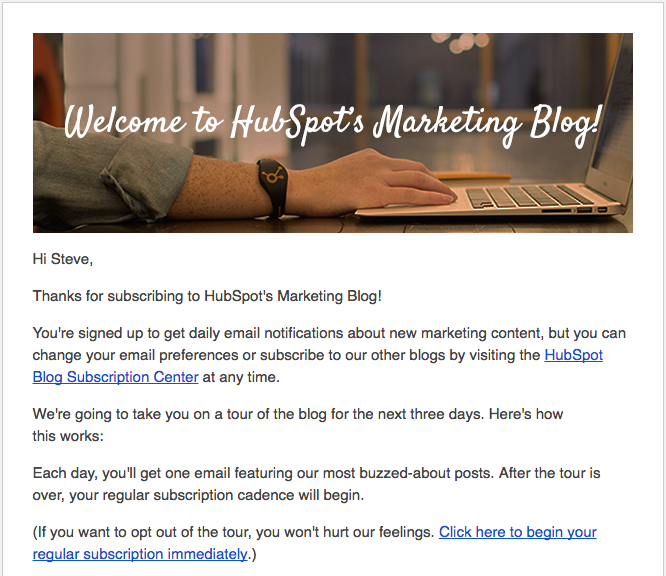
Here at NewsCred, we have subscribers and members on our
Insights blog.
Subscribers enter their email addresses to sign up for our
newsletter. Members provide more information, including their
company name and job title, to not only sign up for our newsletter,
but to access our high-value content, like whitepapers and
webinars.
Subscribers and members receive different welcome series.
Our goal with the subscriber welcome series is to upsell you to
become a member. While we value subscribers and members, we
consider members to be slightly more engaged since they’re
providing more time and effort to obtain our content.
…
COMMENTS